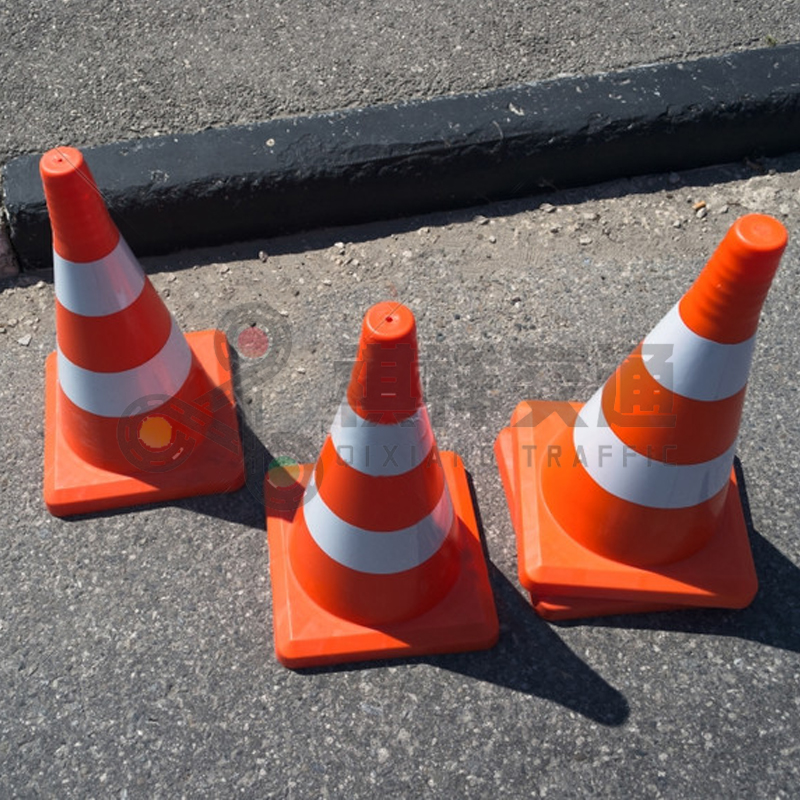Highway traffic cones are an important tool for managing road safety and directing traffic in a variety of situations, from construction zones to accident scenes. Their bright color and reflective surface make them highly visible, ensuring drivers can see them from a distance. However, despite their simple design, there are several important considerations to keep in mind when using highway traffic cones effectively and safely. This article will explore the key points to note when deploying these important security devices.
1. Visibility and Placement
One of the main functions of highway traffic cones is to improve visibility. When placing cones, it is critical to ensure that they are placed in a way that maximizes visibility to oncoming traffic. Here are some tips:
- Use bright colors: Most traffic cones are orange or fluorescent yellow and are very visible. Make sure the cone you use is in good condition and has not faded over time.
- Reflective Strips: Many cones feature reflective strips to increase visibility at night or in low-light conditions. When working in this type of environment, be sure to choose a cone with these features.
- Proper Spacing: The spacing between cones should be sufficient to guide the driver effectively. For example, in construction areas, cones should be placed closer together to provide a clear path for vehicles.
2. Comply with regulations
Different regions have specific regulations on the use of highway traffic cones. It is critical to familiarize yourself with local laws and guidelines to ensure compliance. This may include:
- Height and Dimensions: Regulations may specify minimum heights and dimensions for cones used on highways. Make sure the cone you use meets these requirements.
- Color Standards: Some jurisdictions may have specific color requirements for cones used in certain situations. Be sure to check local guidelines to avoid fines or penalties.
- Placement Protocol: There may be rules about how far away from the road the cones should be placed or how they should be arranged in various situations. Following these protocols is critical to safety.
3. Weather Considerations
Weather conditions can significantly affect the effectiveness of highway traffic cones. Here are some factors to consider:
- Wind: In windy conditions, cones can be easily knocked over. Consider using weighted cones or securing them with other materials to prevent them from shifting.
- Rain and Snow: Wet or snowy conditions can reduce visibility. Make sure the cones are placed where they are unlikely to be obscured by water or snow accumulation.
- Lighting: In low light conditions, additional lighting may be required to ensure the cone is visible. Consider using portable lights or reflective markers to increase visibility.
4. Traffic Management
Highway traffic cones are commonly used to manage traffic flow. When using them for this purpose, consider the following:
- Clear instructions: Ensure the arrangement of cones provides clear instructions to the driver. For example, if you are redirecting traffic, cones should create a clear path that is easy to follow.
- Avoid Confusion: Overuse of cones can lead to confusion. Use them wisely to create clear, direct traffic patterns.
- Emergency: In the event of an emergency such as an accident or road closure, road cones should be deployed quickly and effectively to guide traffic away from danger. Make sure everyone involved is trained in proper cone placement.
5. Maintenance and Inspection
Regular maintenance and inspection of highway traffic cones is critical to ensuring their effectiveness. Here are some maintenance tips:
- CHECK FOR DAMAGE: Check your cones regularly for any signs of damage, such as cracks or discoloration. Damaged cones should be replaced immediately to maintain visibility and effectiveness.
- CLEANNESS: Dirt and debris can block the visibility of your cones. Clean them regularly to ensure they stay bright and reflective.
- STORAGE: When not in use, store cones in a dry, safe location to prevent damage. Proper storage can extend the life of your cones and ensure they are available when needed.
6. Training and Awareness
Finally, it is important to ensure that all personnel involved in highway traffic cone deployment receive adequate training. This includes:
- Know the regulations: Training should cover local regulations regarding the use of traffic cones, ensuring all employees understand the legal requirements.
- Safety Protocols: Personnel should be trained on safety protocols to minimize risks when placing cones on busy highways. This includes wearing visible clothing and using appropriate signaling equipment.
- Emergency Response: During an emergency, staff should know how to deploy cones quickly and efficiently to manage traffic and ensure safety.
In conclusion
Highway traffic cones are valuable tools for maintaining road safety and managing traffic flow. However, their effectiveness depends on correct use, compliance with regulations and ongoing maintenance. By considering visibility, weather conditions, traffic management and training, you can ensure highway traffic cones are doing their job effectively, providing safer roads for everyone. Whether you’re a construction manager, traffic control officer, or simply someone responsible for road safety, understanding these points will help you make the most of your highway traffic cones to their full potential.
Post time: Sep-27-2024







